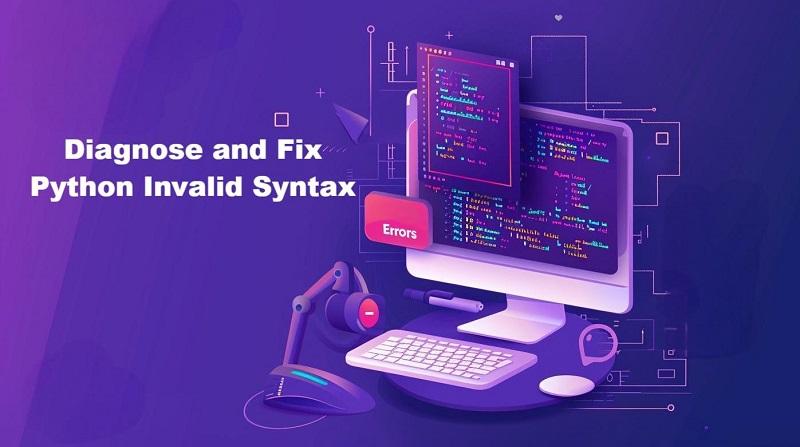How to Diagnose and Fix Python Invalid Syntax Errors
Python’s clean, indentation‐based syntax makes it easy to read and write—but when you hit an “invalid syntax” error, even simple scripts can grind to a halt. For newcomers, these errors can be mystifying: “My code looks fine—why won’t it run?” In this guide, we’ll demystify Python’s Syntax Error, break down the most common scenarios, root causes, and walk you through a clear, step-by-step troubleshooting workflow.

What Are Syntax Errors in Python?
When you run a Python script, the interpreter first parses your code to check for correct syntax. If it encounters something it doesn’t understand, it immediately raises a SyntaxError and stops—no code runs. A typical message looks like:
bash
File "script.py", line 8
print("Hello World"
^
SyntaxError: unexpected EOF while parsing
- File & line number tell you where Python detected the issue.
- Caret (^) points to the approximate location.
- Error message (e.g., “unexpected EOF”) hints at what’s wrong.
Pro Tip: The real mistake usually occurs on the line above where the caret appears.
Common Error Scenarios & Their Root Causes
Below are the most frequent “invalid syntax” scenarios. For each, you’ll see why it happens and how to fix it.
| Error Scenario | Root Cause & Fix |
|
1. Missing or Misplaced Punctuation |
Why: Unterminated strings, unclosed (, [ or {, or missing commas. Fix: - Match every opening quote/bracket with its closer. - Use commas between list or dict items: ['a', 'b'] or {'x': 1, 'y': 2}. |
|
2. Indentation & Whitespace Pitfalls |
Why: Python uses whitespace to group code blocks; mixing tabs and spaces, or inconsistent indent levels, breaks parsing. Fix: - Configure your editor to use 4 spaces. - Convert tabs to spaces globally. - Reveal invisible characters to spot stray tabs. |
| 3. Keyword Typos & Case Sensitivity |
Why: Misspelling or capitalizing Python keywords (fro vs for, Else vs else). Fix: - Check code against a keyword list (your IDE’s syntax highlighting helps). - Remember Python is case-sensitive. |
| 4. Assignment vs Comparison Errors |
Why: Using = in a condition instead of ==, or trying to assign to an expression (len("hi") = 2). Fix: - Use = only for assignment statements. - Use == for equality tests: if x == 5:. |
| 5. Function Definition & Call Mistakes |
Why: Omitting the colon in def func():, or passing positional args after keywords (func(a=1, 2)). Fix: - Always end def lines with :. - List positional arguments before keywords: func(2, a=1). |
| 6. Collection & Literal Syntax Mistakes |
Why: Using = instead of : in dicts ({'a'=1}) or forgetting trailing commas in single-item tuples ((42)). Fix: - Dicts need colons: {'a': 1}. - One-element tuples require a comma: (42,). |
| 7. Version-Specific Quirks |
Why: Mixing Python 2 syntax (print "hi") with Python 3, or using f-strings on interpreters older than 3.6. Fix: - Confirm your Python version (python --version). - Migrate old print statements: print("hi"). - Avoid f-strings if targeting <3.6. |
Decoding Errors & Troubleshooting Workflow
Follow these steps every time you see a SyntaxError:
1. Read the Traceback
Identify the file and line number. Note the caret’s position—and check one line above, too.
2. Isolate the Problem
Comment out suspect lines (# print(x)). Reintroduce each line one by one to pinpoint the error.
3. Retype & Reveal
Manually retype lines flagged by the error to eliminate hidden Unicode or non-breaking spaces. Use your editor’s “Show Invisibles” to find stray characters.
4. Mini REPL Tests
Copy small snippets into the Python shell (REPL). The interactive prompt gives instant feedback on syntax.
5. Swap & Verify
Double-check = vs ==, keyword spelling, and bracket matching. Rely on your editor’s real-time linting to catch mistakes immediately.
By breaking the problem into tiny experiments, you transform a cryptic error into a solvable puzzle.
Additional Gotchas & Proactive Fixes
Beyond the big seven scenarios, watch for these common edge cases:
Zero-Width Spaces: Copying from web pages can introduce invisible characters. Retype suspect sections.
Hanging Operators: A trailing +, -, or \ at the end of a line will shift the error to the next line. Always complete an expression on the same line.
Mixed-Line Endings: Files edited on different OS (Windows vs macOS/Linux) may combine \r\n and \n. Configure your editor for consistent line endings.
Misplaced Comments: A # inside a string literal breaks the quote—move comments outside string quotes.
Preventing Syntax Errors Before They Happen
Good habits save time in the long run:
Consistent Formatting
Enforce 4-space indents; don’t mix tabs. Run an auto-formatter (black) on every save.
Small, Testable Chunks
Write and test functions under ~20 lines. Keep modules focused on a single responsibility.
Editor & Linter Integration
Enable linters (flake8, pylint) to flag syntax issues before running. Use an IDE with real-time error highlighting.
Version Control Discipline
Commit frequently. If a syntax error slips in, git bisect helps you find the exact commit quickly.
Tools & Resources for Beginners
Code Editors/IDEs: VS Code, PyCharm, or any editor with Python plugins.
Linters & Formatters: flake8, pylint for errors; black for automated formatting.
Interactive Shells: IPython or Jupyter Notebooks for rapid experimentation.
Residential Proxy Testing: When your scripts need to fetch data from geo-restricted sites or high-volume APIs, integrating a rotating residential proxy service helps you avoid IP blocks and achieve reliable results every time. Reputational providers, like OkeyProxy.
Community FAQs & Forums: Official Python docs, beginner-friendly Q&A sites, and curated FAQs on common syntax pitfalls.
Conclusion
Syntax errors are a rite of passage for every Python learner. By understanding why they occur and following a structured workflow—reading tracebacks carefully, isolating problems, and leveraging editor tools—you’ll transform “invalid syntax” from a blocker into a fast learning opportunity. Adopt preventive practices like consistent formatting and small, testable code units, and you’ll spend less time fixing errors and more time building cool projects.























